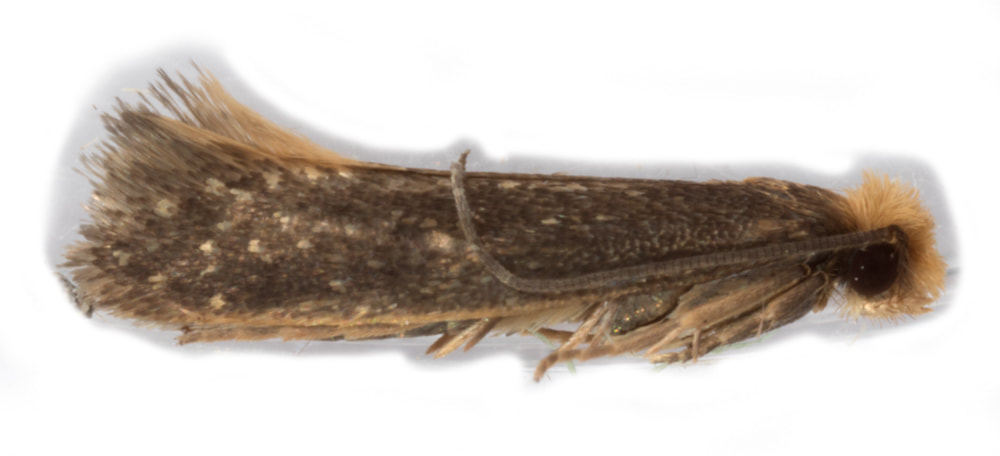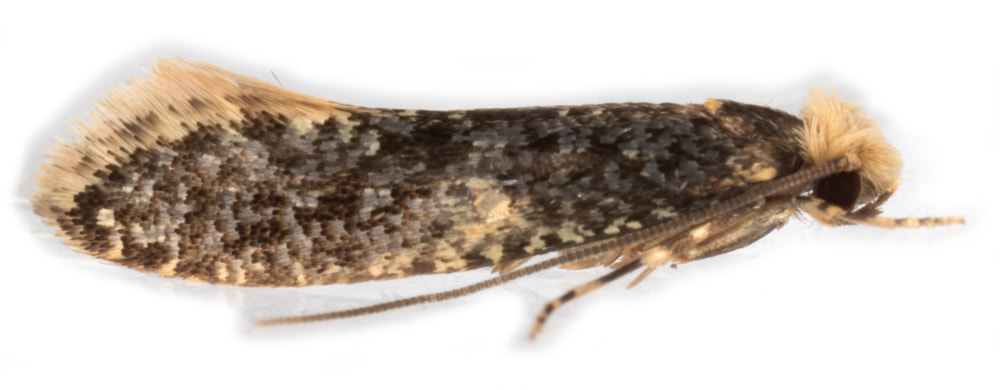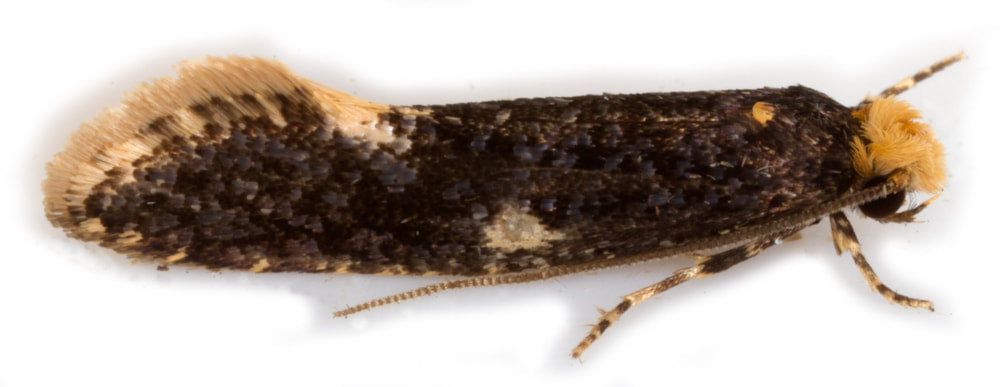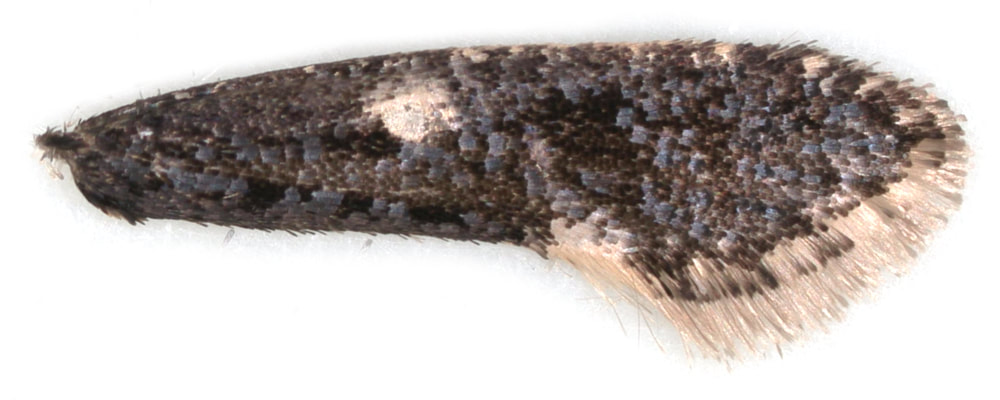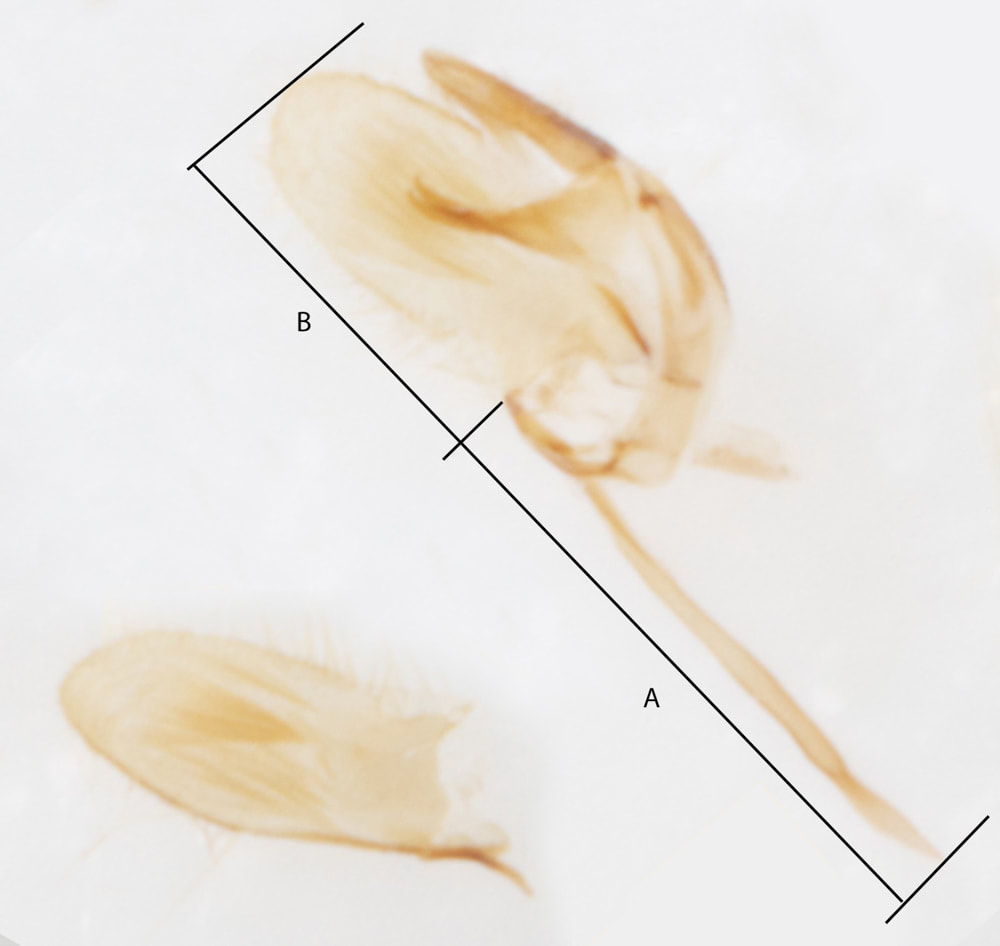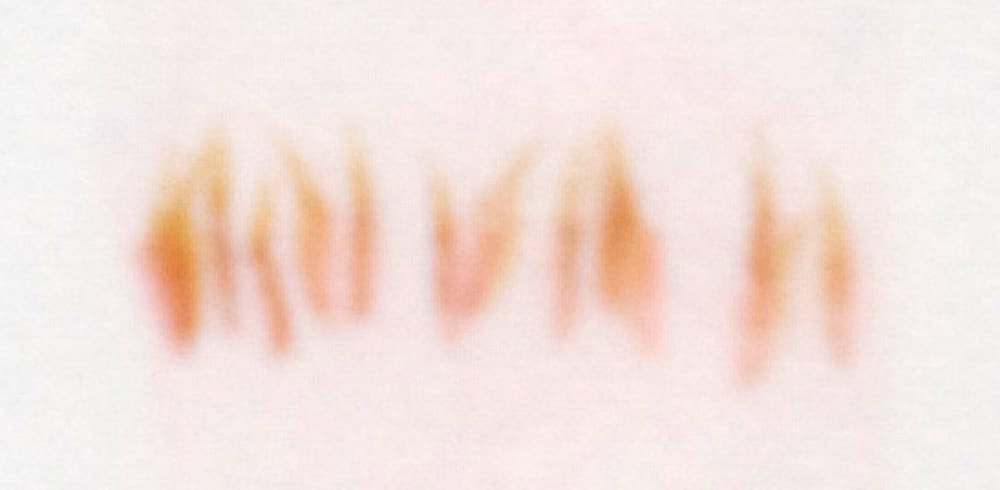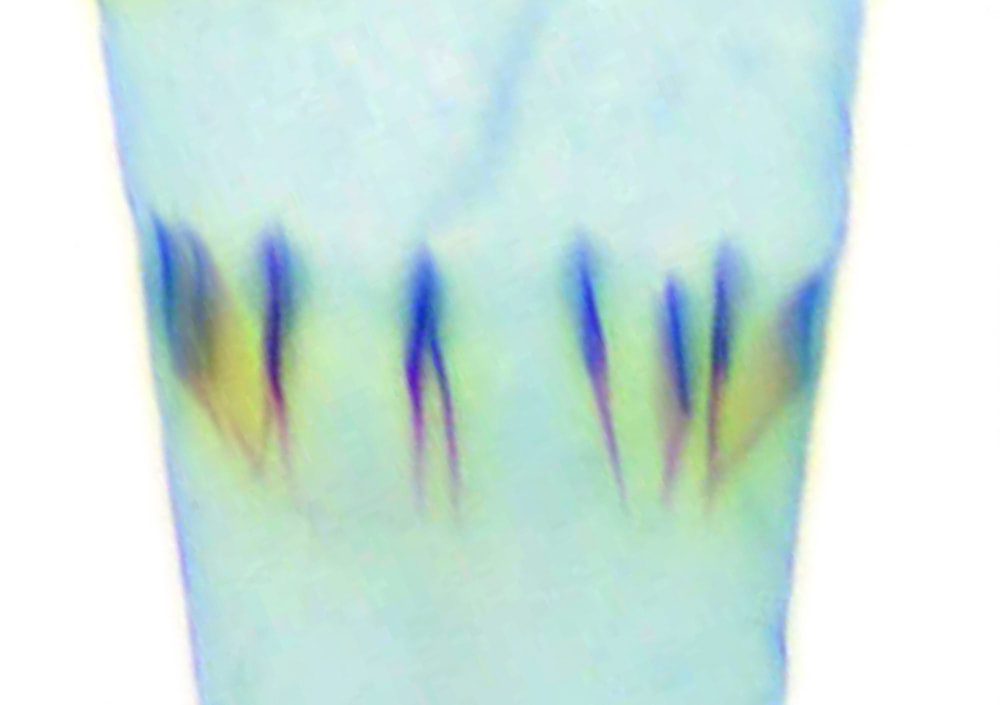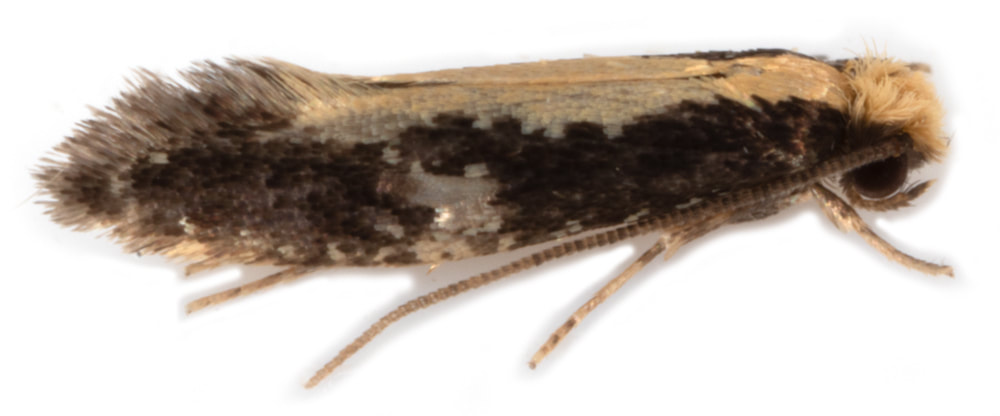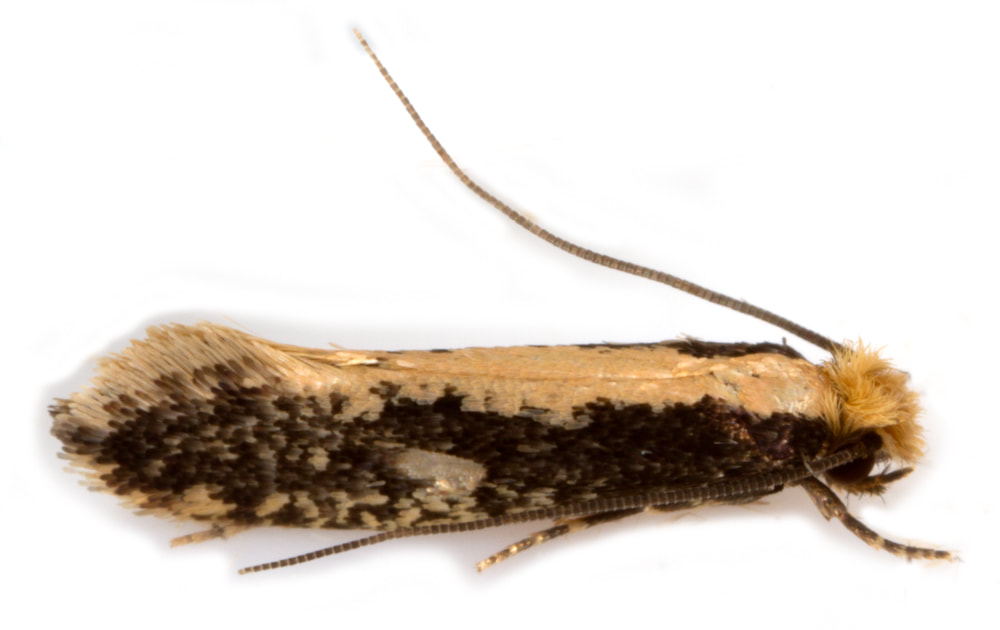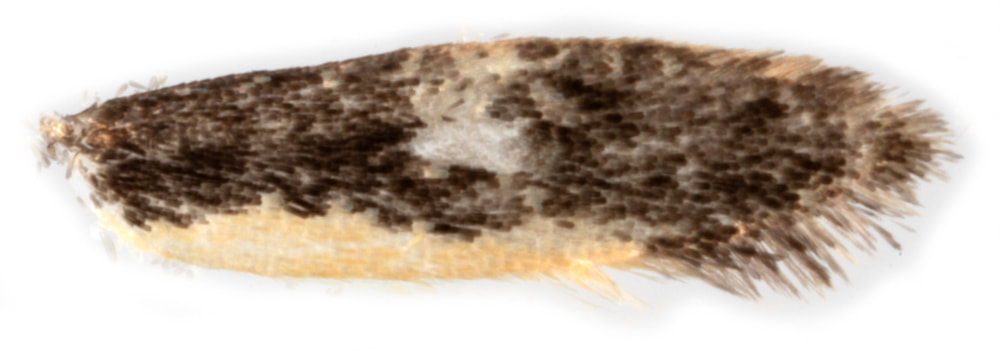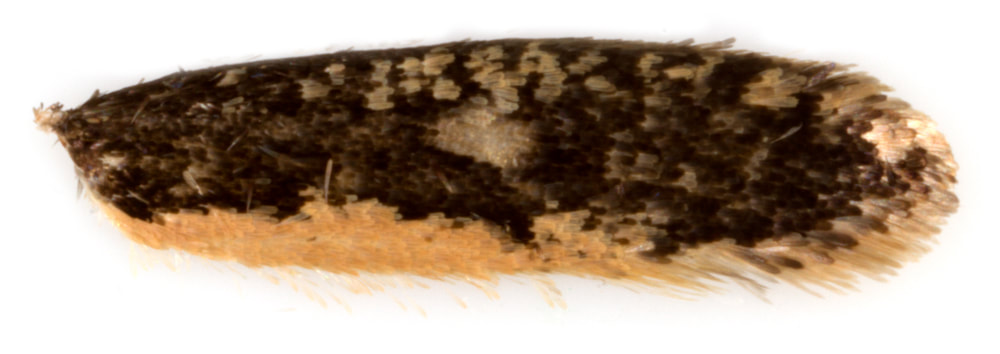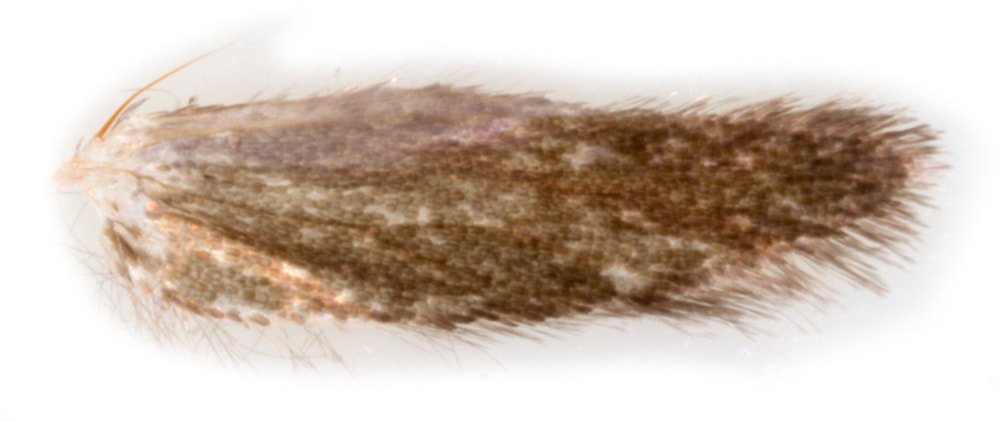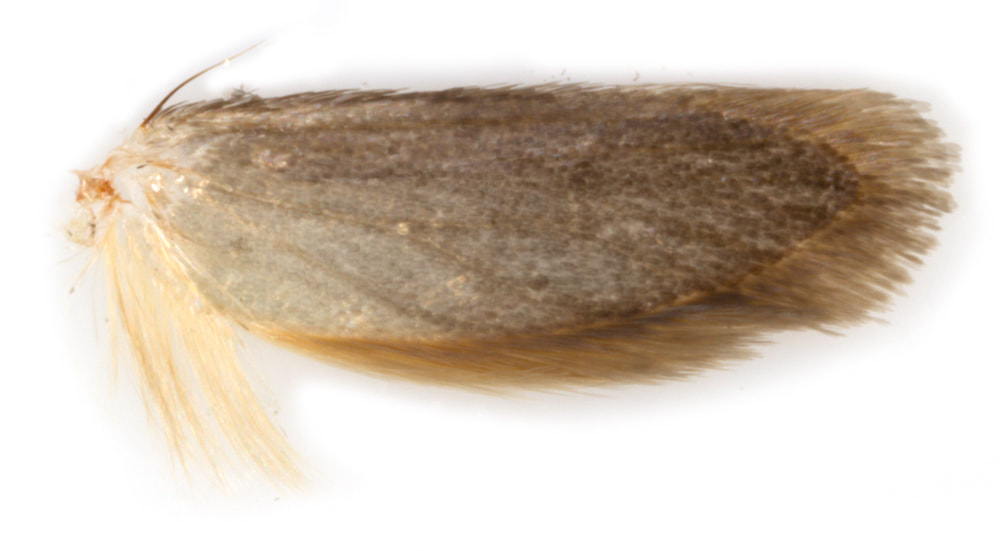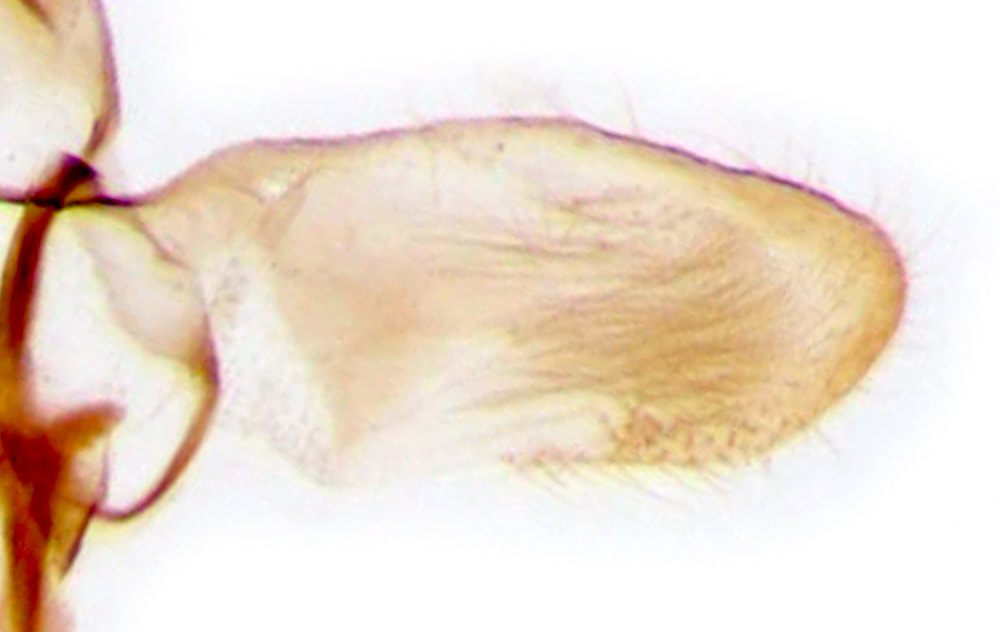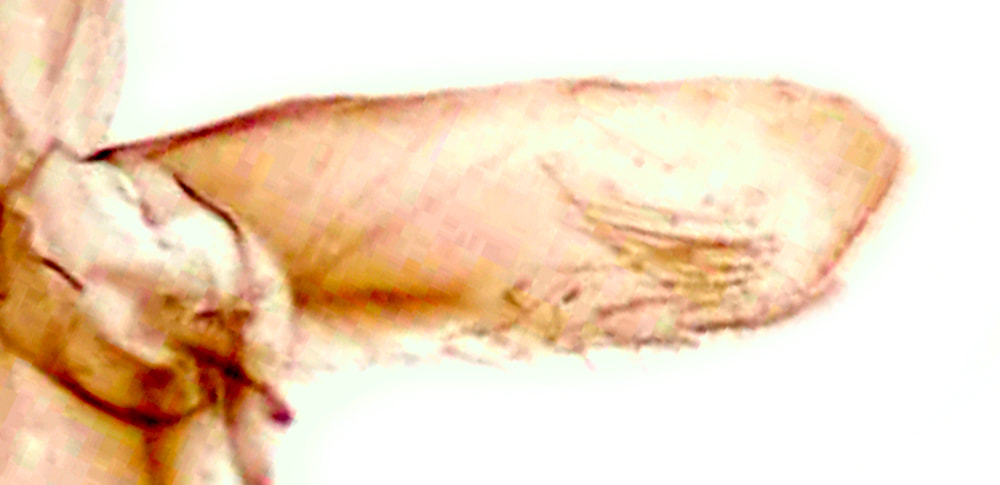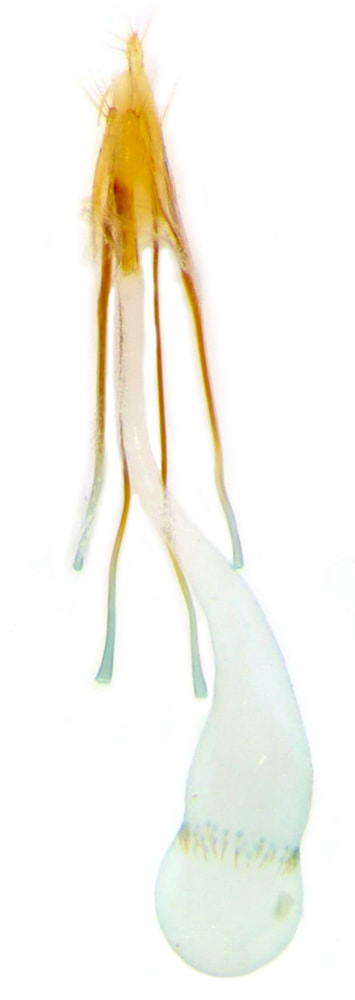Monopis |
Generic features:
Antenna nearly as long as forewing, scape usually with pecten,
maxillary palp longer than labial palp,
proboscis reduced,
a round or oval hyaline spot at end of cell in forewing.
Antenna nearly as long as forewing, scape usually with pecten,
maxillary palp longer than labial palp,
proboscis reduced,
a round or oval hyaline spot at end of cell in forewing.
There are 7 British Monopis species. M.monachella is a rare, but quite distinctive RDB species, with a white head and thorax and a large white costal patch in the apical half of the forewing (which obscures the hyaline spot). The remaining 6 species are similar with dark forewings, a pale yellow to ochreous-orange head and a usually distinctive subcostal hyaline spot near the centre of the forewing length; the forewing usually shows some scattered pale whitish or ochreous scales.
M.fenestrella is a very rare RDB species that shows triangular, dull ochreous (paler than the ground colour), costal and dorsal patches distal to the hyaline spot.
M.imella has a narrowly ochreous costa and the hyaline spot is sufficiently obscure that is may not be recognised unless carefully looked for.
The remaining 4 species fall into two pairs: M.laevigella and M.weaverella without a pale dorsal streak; M.obviella and M.crocicapitella with a pale dorsal streak. These species pairs are considered in more detail below.
M.fenestrella is a very rare RDB species that shows triangular, dull ochreous (paler than the ground colour), costal and dorsal patches distal to the hyaline spot.
M.imella has a narrowly ochreous costa and the hyaline spot is sufficiently obscure that is may not be recognised unless carefully looked for.
The remaining 4 species fall into two pairs: M.laevigella and M.weaverella without a pale dorsal streak; M.obviella and M.crocicapitella with a pale dorsal streak. These species pairs are considered in more detail below.
Monopis laevigella vs Monopis weaverella
External features: M.weaverella is usually most easily distinguished from M.laevigella by having a large pale tornal spot (MBGBI2)
However, M.laevigella sometimes has a pale tornal spot. Further features given in MBGBI2 for separation of these two species are:
1) Position of the pale hyaline spot at .4 from base to apex of forewing in M.laevigella and .45 in M.weaverella. - I have found this to be an entirely unreliable distinction
2) Irroration with transparent whitish scales more marked in M.laevigella.
3) More striking contrast between darker wing and pale cilia in M.weaverella.
However, M.laevigella sometimes has a pale tornal spot. Further features given in MBGBI2 for separation of these two species are:
1) Position of the pale hyaline spot at .4 from base to apex of forewing in M.laevigella and .45 in M.weaverella. - I have found this to be an entirely unreliable distinction
2) Irroration with transparent whitish scales more marked in M.laevigella.
3) More striking contrast between darker wing and pale cilia in M.weaverella.
Male genitalia: the valvae are more elongate in M.weaverella and the saccus is longer in M.laevigella (see below)
The gnathos is also said to have a blunter tip in M.weaverella, but I have found this distinction less convincing.
The gnathos is also said to have a blunter tip in M.weaverella, but I have found this distinction less convincing.
With a more elongate valva in M.weaverella and a longer saccus in M.laevigella the saccus:valva length ratio (A/B in the images below) should provide absolute confirmation of the identification.* In the examples here A/B = 1.65 for M.laevigella and 1.16 for M.weaverella. The range of values for A/B obtained from examination of my material and images at Moth Dissection are: 1.39-1.77 for M.laevigella** and 0.94 - 1.16 for M.weaverella. So the ratio of saccus:valva length (as measured here) will be >1.3 in M.laevigella and <1.2 in M.weaverella.
The valva length:breadth ratio also provides an absolute measure that will distinguish these two species = 1.8-1.9 in M.laevigella; 2.5-2.9 in M.weaverella,
The valva length:breadth ratio also provides an absolute measure that will distinguish these two species = 1.8-1.9 in M.laevigella; 2.5-2.9 in M.weaverella,
* There is a problem in determining the exact length of the valva for this calculation because the position of the base of the valva cannot be reliably determined. I have overcome this problem by taking the base of the saccus as the base of the valva as well. This seems to work best with the genitalia observed in lateral view (it is not essential to remove the right valva) as there is less likely to be any distortion in this view. As few of the images at Moth Dissection allow the measurement to made in this way further refinement of the ranges for each species may be possible if I examine more material.
** One of the images labelled as M.laevigella at Moth Dissection has a ratio of 1.1 - I strongly suspect this to be a misidentification and have not included it.
** One of the images labelled as M.laevigella at Moth Dissection has a ratio of 1.1 - I strongly suspect this to be a misidentification and have not included it.
Female genitalia: In comparing of the images of female genitalia of M.weaverella/laevigella at Moth Dissection, both show a ring of signa at around halfway along the corpus bursae. In M.laevigella ~16 relatively fine signa are shown; in M.weaverella ~8 angular relatively coarse signa are shown. Possibly a short sclerotised section of DB from ostium is present in M.laevigella and not in M.weaverella?
Monopis obviella vs Monopis crocicapitella
External features: According to MBGBI2 these two species can be distinguished on the following features:
1) Dorsal streak pale yellow in M.obviella, ochreus in M.crocicapitella.
2) Pale irroration limited to whitish scales near costa in M.obviella, more generalised especially in the apical region in M.crocicapitella.
3) Hindwing dark fuscous in M.obviella, pale grey in M.crocicapitella.
I have insufficient experiece of M.obviella to assess the reliability of these features, but I will comment that the dorsal streak of M.crocicapitella becomes paler with wear; the pale irroration near the costa is more obvious than the apical irroration in M.crocicapitella and the hindwing of M.crocicapitella seems to be more mid-grey than pale grey to me. For now I would not confidently identify M.obviella without genital dissection.
1) Dorsal streak pale yellow in M.obviella, ochreus in M.crocicapitella.
2) Pale irroration limited to whitish scales near costa in M.obviella, more generalised especially in the apical region in M.crocicapitella.
3) Hindwing dark fuscous in M.obviella, pale grey in M.crocicapitella.
I have insufficient experiece of M.obviella to assess the reliability of these features, but I will comment that the dorsal streak of M.crocicapitella becomes paler with wear; the pale irroration near the costa is more obvious than the apical irroration in M.crocicapitella and the hindwing of M.crocicapitella seems to be more mid-grey than pale grey to me. For now I would not confidently identify M.obviella without genital dissection.
Male genitalia: 1) Valvae shorter and broader with a more rounded apex in M.obviella, longer and narrower with a more angular apex in M.crocicapitella. Length:breadth ratio of valva ~2.1-2.3 in M.obviella 2.8-2.9 in M.crocicapitella.
2) Aedeagus blob-ended at apex in M.obviella, more tapered in M.crocicapitella.
2) Aedeagus blob-ended at apex in M.obviella, more tapered in M.crocicapitella.
Female genitalia: according to Moth Dissection with "band of regular cornuti" in bursa copulatrix of M.obviella, and "a few large cornuti, others irregular and scattered" in M.crocicapitella. However, I think that "cornuti" should refer to thorns in the male genitalia; "signa" being the more usual term for those in the female genitalia; and the images presented at Moth Dissection are not entirely convincing when it comes to this stated difference between the species. On the M.crocicapitella page the bursa copulatrix is not shown and the sclerotised antrum is of even diameter and about 4x longer than wide. On the M.obviella page, there is one image showing the whole genitalia, labelled as M.obviella, with an inset purporting to show the difference in the signa between the two species - in this image the antrum looks the same as in the M.crocicapitella image. On the M.obviella page there is a second image, which does not show the bursa but does show the sclerotised antrum to be much shorter and quite different from that in the other image labelled as M.obviella. I await a female specimen of M.obviella before commenting further.
Page published 19/02/2020 | Images of male M.obviella upgraded 27/08/2020
